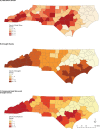Impacts of compounding drought and heatwave events on child mental health: insights from a spatial clustering analysis
- PMID: 38168712
- PMCID: PMC10761644
- DOI: 10.1007/s44192-023-00055-0
Impacts of compounding drought and heatwave events on child mental health: insights from a spatial clustering analysis
Abstract
Background: Concurrent heatwave and drought events may have larger health impacts than each event separately; however, no US-based studies have examined differential mental health impacts of compound drought and heatwave events in pediatric populations.
Objective: To examine the spatial patterns of mood disorders and suicide-related emergency department (ED) visits in children during heatwave, drought, and compound heatwave and drought events. We tested whether the occurrence of compound heatwave and drought events have a synergistic (multiplicative) effect on the risk of mental health related outcomes in children as compared to the additive effect of each individual climate hazard. Lastly, we identified household and community-level determinants of geographic variability of high psychiatric burden.
Methods: Daily counts of psychiatric ED visits in North Carolina from 2016 to 2019 (May to Sept) for pediatric populations were aggregated at the county scale. Bernoulli cluster analyses identified high-risk spatial clusters of psychiatric morbidity during heatwave, drought, or compound heatwave and drought periods. Multivariate adaptive regression models examined the individual importance of household and community-level determinants in predicting high-risk clustering of mood disorders or suicidality across the three climate threats.
Results: Results showed significant spatial clustering of suicide and mood disorder risks in children during heatwave, drought, and compound event periods. Periods of drought were associated with the highest likelihood of spatial clustering for suicide and mood disorders, where the risk of an ED visit was 4.48 and 6.32 times higher, respectively, compared to non-drought periods. Compounding events were associated with a threefold increase in both suicide and mood disorder-related ED visits. Community and household vulnerability factors that most contributed to spatial clustering varied across climate hazards, but consistent determinants included residential segregation, green space availability, low English proficiency, overcrowding, no broadband access, no vehicle access, housing vacancy, and availability of housing units.
Conclusion: Findings advance understanding on the locations of vulnerable pediatric populations who are disproportionately exposed to compounding climate stressors and identify community resilience factors to target in public health adaptation strategies.
Keywords: Compounding climate hazards; Drought; Heatwave; Mood disorders; Pediatric mental health; Suicide.
© 2023. The Author(s).
Conflict of interest statement
The authors have no relevant financial or non-financial interests to disclose.
Figures



Similar articles
-
Resistance of grassland productivity to drought and heatwave over a temperate semi-arid climate zone.Sci Total Environ. 2024 Nov 15;951:175495. doi: 10.1016/j.scitotenv.2024.175495. Epub 2024 Aug 16. Sci Total Environ. 2024. PMID: 39155014
-
Sociodemographic factors and vulnerability to multiple extreme weather events: A national study in the U.S.Sci Total Environ. 2025 Mar 1;967:178761. doi: 10.1016/j.scitotenv.2025.178761. Epub 2025 Feb 13. Sci Total Environ. 2025. PMID: 39952211
-
Spatial-temporal evolution and intrinsic drivers of compound drought and heatwave events in Mainland China.Sci Total Environ. 2024 Oct 20;948:174834. doi: 10.1016/j.scitotenv.2024.174834. Epub 2024 Jul 19. Sci Total Environ. 2024. PMID: 39025155
-
Drought-heatwave nexus in Brazil and related impacts on health and fires: A comprehensive review.Ann N Y Acad Sci. 2022 Nov;1517(1):44-62. doi: 10.1111/nyas.14887. Epub 2022 Sep 2. Ann N Y Acad Sci. 2022. PMID: 36052446 Review.
-
Systematic review of the impact of heatwaves on health service demand in Australia.BMC Health Serv Res. 2022 Jul 28;22(1):960. doi: 10.1186/s12913-022-08341-3. BMC Health Serv Res. 2022. PMID: 35902847 Free PMC article.
Cited by
-
Extreme drought and sexual violence against adolescent girls and young women: A multi-country population-based study.PLOS Glob Public Health. 2025 Jun 26;5(6):e0004752. doi: 10.1371/journal.pgph.0004752. eCollection 2025. PLOS Glob Public Health. 2025. PMID: 40569888 Free PMC article.
-
Spatial-temporal assessment of future population exposure to compound extreme precipitation-high temperature events across China.PLoS One. 2024 Aug 14;19(8):e0307494. doi: 10.1371/journal.pone.0307494. eCollection 2024. PLoS One. 2024. PMID: 39141652 Free PMC article.
-
Compound drought and heatwave extreme weather events: Mortality risk in individuals with chronic respiratory disease.Environ Epidemiol. 2025 May 1;9(3):e389. doi: 10.1097/EE9.0000000000000389. eCollection 2025 Jun. Environ Epidemiol. 2025. PMID: 40313866 Free PMC article.
-
Climate change and environmental sustainability in emergency medicine: a narrative review.Ann Transl Med. 2025 Jun 27;13(3):31. doi: 10.21037/atm-25-57. Epub 2025 Jun 24. Ann Transl Med. 2025. PMID: 40689074 Free PMC article. Review.
-
Climate change and suicide epidemiology: a systematic review and meta-analysis of gender variations in global suicide rates.Front Public Health. 2025 Jan 8;12:1463676. doi: 10.3389/fpubh.2024.1463676. eCollection 2024. Front Public Health. 2025. PMID: 39845688 Free PMC article.
References
-
- Seneviratne SI, Zhang X, Adnan M, Badi W, Dereczynski C, Luca AD, Zhou B. Chapter 11: weather and climate extreme events in a changing climate. Climate change 2021: The Physical Science Basis Contribution of Working Group I to the Sixth Assessment Report of the Intergovernmental Panel on Climate Change. Cambridge: Cambridge University Press; 2021. pp. 1513–1766.
-
- Leonard M, Westra S, Phatak A, Lambert M, Hurk B, Mcinnes K, Stafford Smith M. A compound event framework for understanding extreme impacts. Wiley Interdiscip Rev Clim Change. 2014 doi: 10.1002/wcc.252. - DOI
-
- Zscheischler J, Westra S, van den Hurk BJJM, Seneviratne SI, Ward PJ, Pitman A, Zhang X. Future climate risk from compound events. Nat Clim Change. 2018;8(6):469–477. doi: 10.1038/s41558-018-0156-3. - DOI
-
- Ionita M, Tallaksen LM, Kingston DG, Stagge JH, Laaha G, Van Lanen HAJ, Haslinger K. The European 2015 drought from a climatological perspective. Hydrol Earth Syst Sci. 2017;21(3):1397–1419. doi: 10.5194/hess-21-1397-2017. - DOI
Grants and funding
LinkOut - more resources
Full Text Sources

